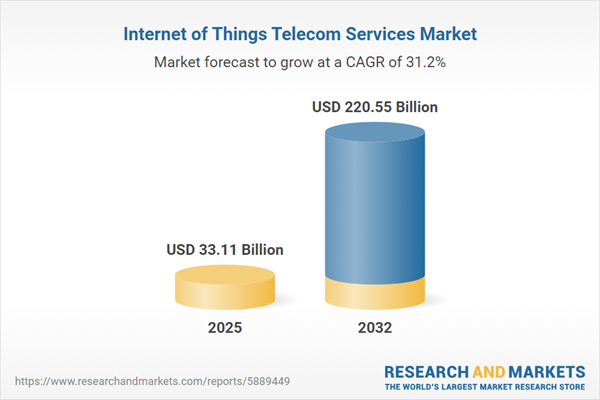Speak directly to the analyst to clarify any post sales queries you may have.
The IoT telecom services market is redefining how enterprises manage connectivity, enabling organizations to drive digital initiatives and remain responsive in dynamic business environments.
Market Snapshot: IoT Telecom Services Market
Driven by next-generation connectivity platforms and the progression of industry standards, the IoT telecom services market is entering a period of robust growth. Between 2024 and 2032, significant market expansion is anticipated as the global deployment of 5G networks progresses and the adoption of low-power wide area (LPWA) technologies accelerates. Core sectors—including manufacturing, healthcare, transportation, and agriculture—are advancing automation and utilizing flexible service models to address increasing operational complexity. As enterprises deepen their digital transformation strategies, IoT telecom services are becoming critical enablers, ensuring organizations strengthen resilience and competitiveness amid continual change.
Scope & Segmentation: IoT Telecom Services Market
This report offers actionable insights for telecom executives evaluating IoT implementation across diverse operational contexts. The analysis supports strategic decision-making by mapping major investment domains and assessing the transformative effect of new telecom technologies on enterprise performance globally.
- Connectivity Technology: Assessment spans 2G/3G, 4G LTE, 5G, LoRaWAN, LTE-M, NB-IoT, Sigfox, and satellite communication options (across GEO, LEO, and MEO), examining how legacy and modern frameworks coexist in enterprise networks.
- Industry Vertical: Focus extends to sectors such as precision agriculture, telematics in automotive, asset monitoring within banking, smart grids for energy, digital health data management, industrial automation in manufacturing, retail analytics, surveillance solutions, smart urban infrastructure, residential automation, and fleet management in transportation.
- Service Type: The report covers IoT analytics (descriptive, predictive, prescriptive), device and eSIM management, connectivity administration, systems integration, remote asset monitoring, consulting services, identity authentication, and enterprise-grade data encryption practices.
- Network Type: Evaluates deployment of multi-protocol label switching (MPLS), public/private network models, hybrid satellite connectivity, and integration across multi-cloud environments to suit varying enterprise needs.
- Deployment Model: Delivers analysis of managed service offerings, self-service solutions, digital portals, and API-centric models that help streamline integration and adaptability for enterprises.
- Regions: Insight provided on the Americas, Asia-Pacific, Europe, and Middle East & Africa, emphasizing regulatory frameworks, telecom infrastructure maturity, and unique digital adoption trajectories within each region.
- Company Coverage: Profiles strategies, alliances, and market positioning among industry leaders such as China Mobile Limited, Vodafone Group, Verizon Communications, AT&T, Telefónica, NTT DOCOMO, Deutsche Telekom, and Orange S.A.
Key Takeaways for Senior Decision-Makers
- Enterprises can adapt their IoT architectures to address shifting operational priorities and industry demands.
- Edge computing—integrated with cloud platforms—enables lower latency and enhanced real-time decision-making for sectors like logistics and advanced manufacturing.
- Modernized governance and compliance frameworks are crucial for navigating evolving regulatory landscapes and protecting enterprise data.
- Regional localization and collaboration strategies foster sustainable market penetration where telecom infrastructure and digital capabilities differ.
- Strengthening cybersecurity postures helps organizations reduce risk from an expanding ecosystem of connected devices and data pathways.
- Modular and flexible investment models support ongoing enterprise agility as technology standards evolve and regulatory expectations shift.
Tariff Impact: Managing Regulatory Shifts in the Value Chain
Recent changes to tariff regulations in the US are leading telecom providers to revisit supply chain strategies and establish more diversified sourcing partners. This approach helps enterprises limit operational risks and decrease dependency on singular suppliers throughout the IoT telecom value chain.
Methodology & Data Sources
The report synthesizes findings from executive interviews, end-user feedback, in-depth technical evaluations, and regulatory reviews. Stringent data triangulation and advanced scenario modeling underpin the reliability of actionable recommendations provided for telecom industry leadership.
Why This Report Matters for Telecom Industry Leaders
- Delivers strategic, data-backed recommendations to help executives enhance enterprise operations and support effective IoT implementation at scale.
- Provides targeted intelligence on global segmental developments, regional regulatory patterns, and compliance challenges.
- Acts as a reliable tool to guide enterprise transformation initiatives and support evolving digital strategies as the IoT telecom landscape grows in complexity and relevance.
Leveraging insights from this research, senior executives can refine digital strategies, optimize enterprise workflows, and achieve operational efficiencies in a changing IoT telecom environment.
Conclusion
Adaptive network investments and integrated security solutions position organizations to sustain long-term advantages as the IoT telecom services market rapidly advances.
Additional Product Information:
- Purchase of this report includes 1 year online access with quarterly updates.
- This report can be updated on request. Please contact our Customer Experience team using the Ask a Question widget on our website.
Table of Contents
3. Executive Summary
4. Market Overview
7. Cumulative Impact of Artificial Intelligence 2025
Companies Mentioned
The companies profiled in this Internet of Things Telecom Services market report include:- China Mobile Limited
- China United Network Communications Group Co., Ltd.
- China Telecommunications Corporation
- Vodafone Group PLC
- Verizon Communications Inc.
- AT&T Inc.
- Telefónica, S.A.
- NTT DOCOMO, Inc.
- Deutsche Telekom Aktiengesellschaft
- Orange S.A.
Table Information
| Report Attribute | Details |
|---|---|
| No. of Pages | 194 |
| Published | November 2025 |
| Forecast Period | 2025 - 2032 |
| Estimated Market Value ( USD | $ 33.11 Billion |
| Forecasted Market Value ( USD | $ 220.55 Billion |
| Compound Annual Growth Rate | 31.2% |
| Regions Covered | Global |
| No. of Companies Mentioned | 11 |









